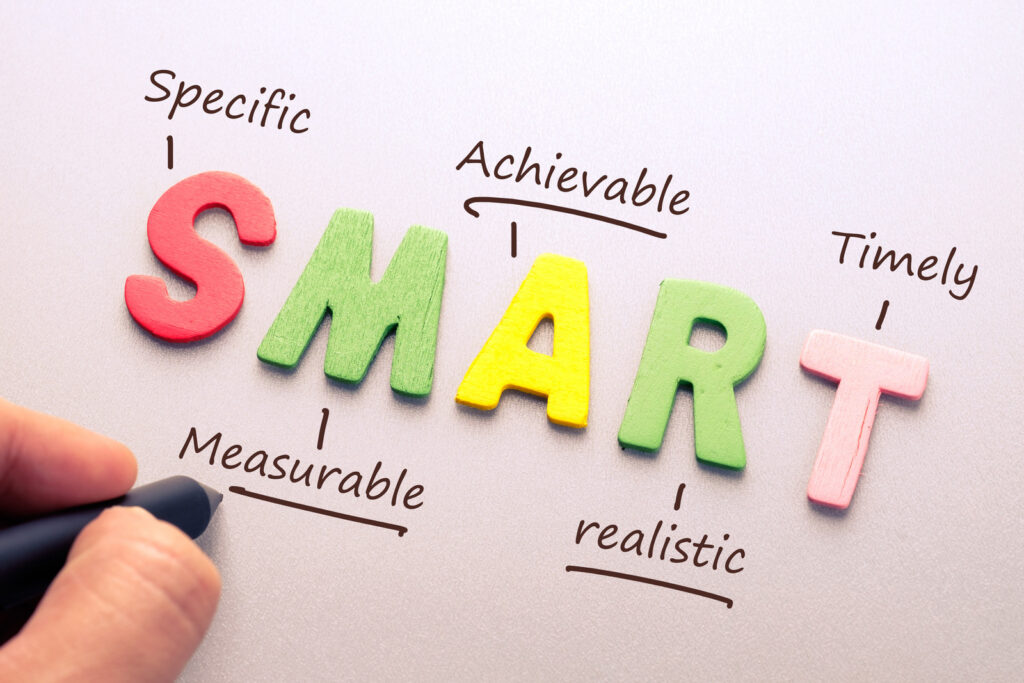Did you know that over 30% of Americans give up on their New Year’s goal within 6 months?
It doesn’t have to be you!
Today I’m going to share a proven framework to propel you toward success with your goals—whatever they are.

Why Set Goals?
In my live time workshops, I’m startled to learn how few people either have achieved their goals or have never even set goals for the year. I encourage them to set goals right there in the workshop, and with the strategies I give them, many are successful in reaching their goals. I’m going to share the most useful one with you.
Goal setting is what motivates me to grow and change each year, and I am excited to set aside 1–or even 2–entire days each January to analyze the previous year and create stretch goals for the year ahead.
As you make goals, here are some questions to consider:
What did you do last year that you were proud of? What are your regrets? (Or, is there anything you didn’t finish that you want to achieve?) What are your personal goals? What are your earning goals? Do you want to gain a new skill or get better at an activity?
As you reflect on the previous year, don’t forget to celebrate your victories and the things that you DID accomplish! Let them give momentum to your goal setting.

What Holds Us Back?
And yet, even when we set goals, it’s so hard to stay true to them. Here are some interesting statistics:
According to a 2016 study, of the 41% of Americans who make New Years resolutions, by the end of the year only 9% feel they are successful in keeping them.
One 2014 study found:
-
- 35% of participants who failed their New Year’s Resolutions said they had unrealistic goals.
-
- 33% of participants who failed didn’t keep track of their progress.
-
- 23% forgot about their resolutions.
-
- About 1 in 10 people who failed said they made too many resolutions.
Don’t lose hope! There is a way to organize goals to make them realistic and easier to keep track of. It’s called SMART goals. I am thankful someone with a brilliant brain thought of this goal framework.
SMART goals are the way to success. This acronym stands for goals that are specific, measurable, achievable, relevant, and timely.

“S” Stands for “Specific”
A specific goal has context. Here’s how I explain it in my workshops:
Can you answer the 5 W’s (and the H) regarding your goal? Who, what, when, where, why, and how? If you can, then your goal is specific enough.
“M” Stands for “Measurable”
How will you measure progress, and how will you measure success? When you reach a certain money goal? Milestone? Weight, degree, or level of skill?
Milestones are an important step on the journey towards a big goal. For example, when someone is getting a degree, each semester they finish successfully is a milestone and needs to be celebrated!
“A” Stands for “Achievable”
Is it a pie-in-the-sky goal? For example, a small-town singer makes a goal to have a Top 20 hit within the year. It is unlikely.
But you also don’t want to make a goal that won’t stretch you at all, or that encompasses something you’re already comfortable doing. A good guideline is to choose something achievable that will make you stretch.
I make a goal for my profits to increase by a certain percentage of last year’s numbers. Or I have a goal to be promoted to assistant manager.
Make sure you have a plan to achieve it. (What letter does that fall under?) What resources do you need to reach it? Don’t forget that people can be resources, too. If you reach out and ask someone to help or mentor you, you will likely achieve that goal faster and feel more accountable since you’ve shared your goal with them.
“R” Stands for “Relevant”
Is it relevant to your life and your big-picture goals? In other words, how will achieving this goal prepare you to achieve another, larger, or more important goal later on? Is it something you care about? Or you’re passionate about?
When you know which direction you want to go, you can plan accordingly. Rather than making too large or drastic of a goal at first, break it into smaller, more manageable pieces. It’s better to improve slowly than be intimidated by a big project and make no progress at all.
“T” Stands for “Timely”
What date do you plan to reach your goal? And, along the way, when do you plan to reach each milestone? Setting a realistic goal means making sure you have estimated how long the goal will take you, whether it is big or small. Milestones along the way help you see how much you’ve accomplished and how much you still have to do.
A deadline can be a big motivator. I know it is for me and my time coaching clients!
A Bit of Encouragement
I encourage you to create some goals for the year.
January is over, and if you are losing motivation, take heart! It is worth it. Growth is never easy. As you take small steps one at a time, you will feel such a sense of accomplishment when you reach the pinnacle of your achievement.
Taking the time to make your goals SMART will set you up for success now and in the future. This extra effort will clarify your objective and solidify your commitment. As you move forward, consider sharing your goals with people who will support and help you. Later, when you achieve them, you can celebrate your progress together!
Resources








